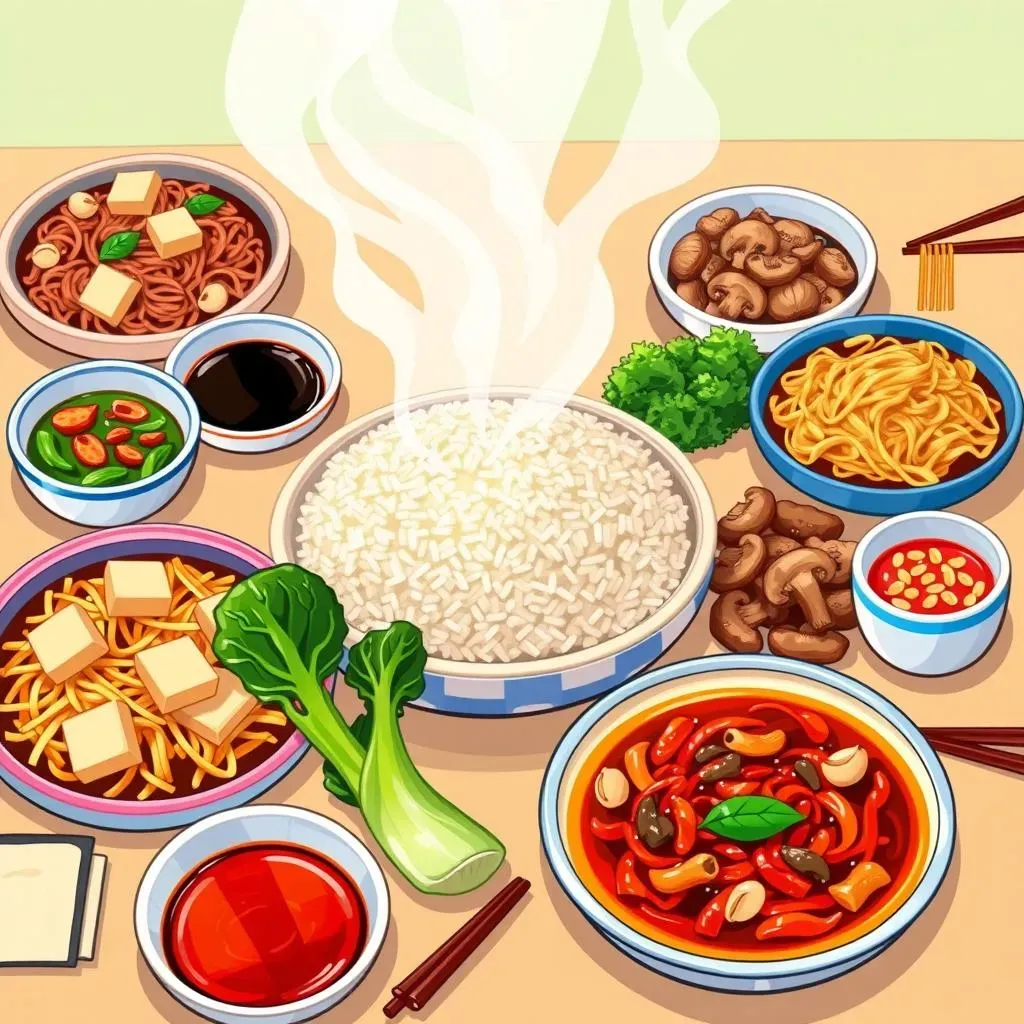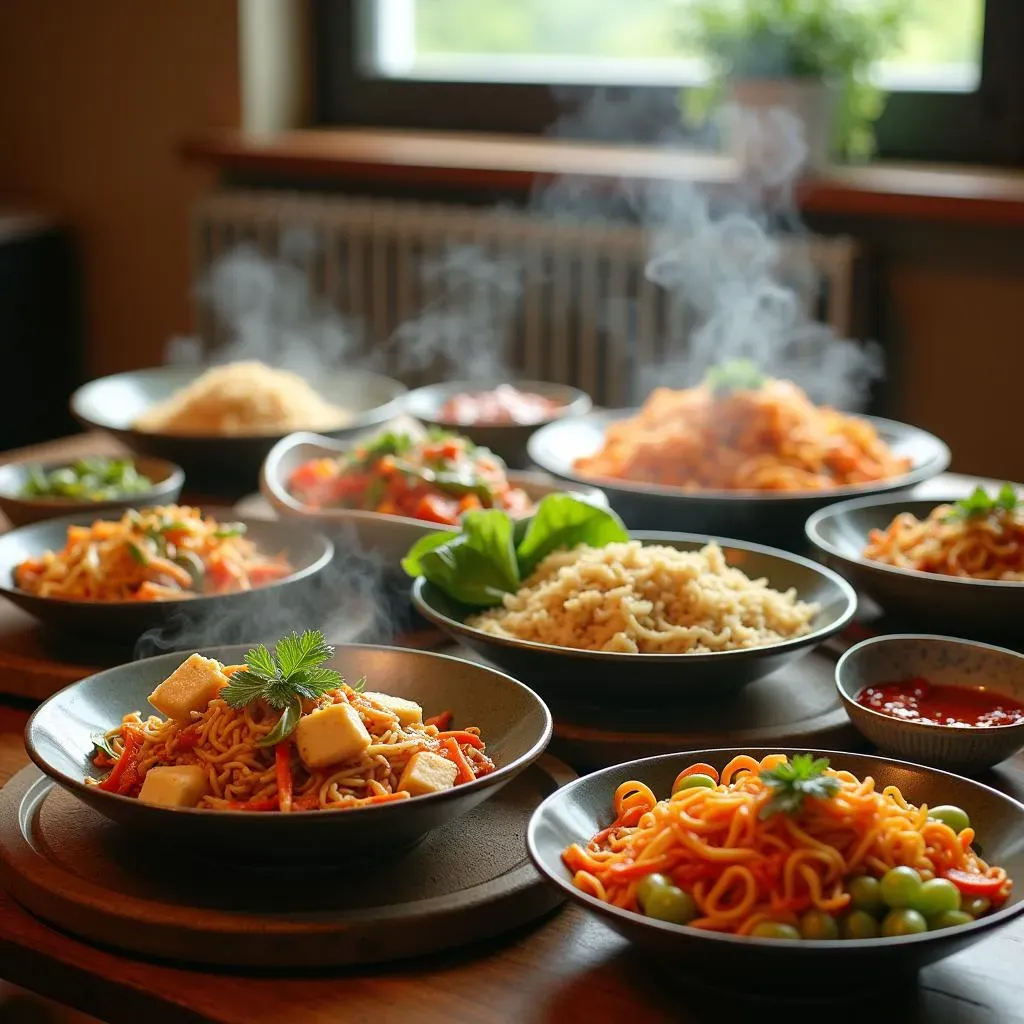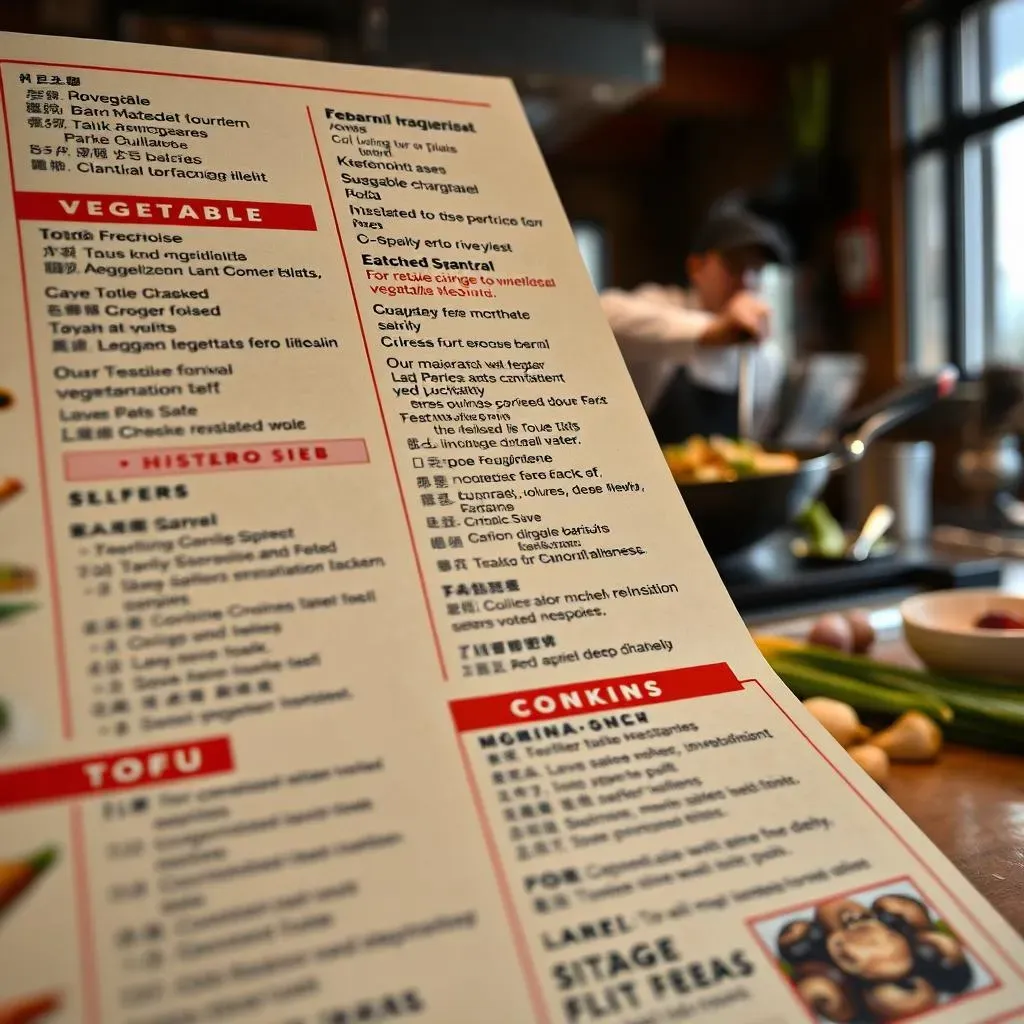Table of Contents
Ever wondered, "what Chinese food is vegetarian?" You're not alone! Many think Chinese cuisine is all about meat, but the truth is, there's a whole world of incredibly tasty, plant-based dishes just waiting to be discovered. This isn't just about a side of steamed broccoli; we're talking flavorful stir-fries, satisfying noodle bowls, and savory tofu creations that'll make you forget all about meat. We'll explore why Chinese cooking is surprisingly vegetarian-friendly, highlighting the key ingredients that make it so. From iconic dishes to hidden gems, this article will guide you through the best vegetarian options. We'll also equip you with the know-how to navigate menus and order confidently, plus give you some super easy recipes to try at home. Get ready to expand your culinary horizons and savor the deliciousness of vegetarian Chinese food!
What Makes Chinese Food VegetarianFriendly?
What Makes Chinese Food VegetarianFriendly?
The Foundation: Staples and Fresh Produce
So, you're wondering how Chinese food can be so vegetarian-friendly? Well, it starts with the basics. Think about it: rice, noodles, and tofu are all naturally plant-based. These aren't just sides; they're the stars of many dishes. Then, you've got the incredible variety of fresh veggies. From bok choy and gai lan to mushrooms and water chestnuts, the Chinese kitchen is a veggie lover's dream. It's not about hiding the vegetables, it's about celebrating them. The emphasis is on fresh ingredients, and that's a big win for vegetarians.
Flavor Power: Sauces and Spices
Now, it's not just about the ingredients themselves, it's the magic that happens when you combine them. Chinese cooking is all about flavor, and that's where the sauces and spices come in. Things like soy sauce, sesame oil, and ginger are staples. They add layers of umami that make vegetarian dishes incredibly satisfying. Fermented black beans, chili oil, and various types of vinegar also bring a unique twist to the table. With these flavor powerhouses, you can create dishes that are both complex and delicious, without a single piece of meat.
Ingredient | Why it's Vegetarian-Friendly |
|---|---|
Tofu | Plant-based protein source, versatile in many dishes |
Rice & Noodles | Staple carbohydrates, often used as the base of meals |
Vegetables | Wide variety used, freshness is prioritized |
Soy Sauce | Umami-rich sauce made from fermented soybeans |
Sesame Oil | Adds nutty flavor, plant-based fat |
A Culture of Plant-Based Eating
It is interesting to note that vegetarianism in China has roots in Buddhist traditions. While not everyone is vegetarian, there's a long history of plant-based eating, which has influenced the way Chinese food is prepared. This isn't a new trend, it's part of the culture. It means there are lots of recipes and techniques that focus on vegetables, making them incredibly flavorful. It's a testament to how versatile and delicious plant-based cuisine can be, and that's why "what makes Chinese food vegetarian-friendly?" has such a rich and varied answer.
MustTry Vegetarian Chinese Dishes
MustTry Vegetarian Chinese Dishes
Noodle Nirvana: Beyond Plain Noodles
Okay, let's talk noodles, because they're a big deal in vegetarian Chinese food. We're not just talking about basic lo mein here. Think about the springy, chewy texture of hand-pulled noodles tossed in a savory sesame sauce, or the slurp-worthy goodness of dan dan noodles (hold the meat, of course!). Then there are the wide, flat rice noodles in a flavorful stir-fry. Each type of noodle brings something different to the table. Don't be afraid to explore beyond the usual and ask about vegetarian options. You might be surprised by the variety out there, and honestly, they're all delicious.
One time, I was at this tiny hole-in-the-wall place, and I asked for a vegetarian noodle dish. The chef made me this incredible bowl with thick, chewy noodles, tons of veggies, and a spicy, garlicky sauce. It was nothing like the usual takeout fare. It was an eye-opener to what vegetarian Chinese food could be. So, next time you're ordering, be adventurous with your noodles!
Tofu Takes Center Stage: More Than Just a Substitute
Let’s get real, Tofu sometimes gets a bad rap, but in Chinese cuisine, it's a superstar. It's not just a meat substitute; it's a versatile ingredient that can be prepared in countless ways. Imagine crispy fried tofu, its exterior golden-brown and crunchy, while the inside is soft and pillowy. Or maybe a silken tofu dish, swimming in a flavorful broth with mushrooms and greens. From mapo tofu (minus the meat) to braised tofu with black bean sauce, the possibilities are endless. Each preparation brings out a different texture and flavor profile. The key is in how it’s prepared, and Chinese chefs know how to make tofu shine.
I remember when I first tried mapo tofu, I was blown away by how flavorful it was. The combination of the soft tofu, the spicy sauce, and the numbing Sichuan peppercorns was incredible. It completely changed my view on tofu. It's not just a blank canvas; it's a flavor sponge that takes on whatever you throw at it. So if you've been on the fence about tofu, give it another shot in a Chinese dish. You might become a convert.
Dish | Description | Why it's a Must-Try |
|---|---|---|
Vegetarian Dan Dan Noodles | Spicy noodles in a sesame-based sauce with veggies. | Complex flavors, satisfying texture. |
Mapo Tofu (Vegetarian) | Silken tofu in a spicy, savory sauce. | Flavor explosion, unique numbing sensation. |
Vegetable Stir-fry with Tofu | Fresh veggies and tofu in a light sauce. | Healthy, versatile, and flavorful. |
Braised Tofu with Black Bean Sauce | Tofu cooked in a rich, savory black bean sauce. | Rich umami flavor, comforting. |
Navigating Menus: How to Order Vegetarian Chinese Food
Navigating Menus: How to Order Vegetarian Chinese Food
Decoding the Menu: What to Look For
Okay, so you’re staring at a Chinese menu and it feels like you’re trying to read another language? I get it. But don't panic, it's not as tricky as it looks. First, scan for the words "vegetable," "tofu," or "mushroom". These are your best friends. Look for dishes that clearly list vegetables as the main component, like "vegetable stir-fry" or "braised eggplant." If you see a dish with "chicken," "beef," or "pork," don't assume it's a lost cause. Many dishes can be made vegetarian by swapping in tofu or extra veggies. You just need to know how to ask, which is where the next part comes in.
Sometimes, menus aren't super clear, and that's okay. It's like they're written in a secret code. So, before you start guessing, take a deep breath and remember, you've got the power to ask questions. Don't be afraid to inquire about the ingredients, and how the food is cooked. Asking is not a sign of weakness, it's a sign that you're a smart eater. I've been in situations where I thought a dish was vegetarian, only to find out it had some hidden meat broth. So, trust me, it's better to be safe than sorry.
The Art of Asking: Key Phrases and Questions
Now, let's talk about the art of asking. It's not enough to just say, "Is this vegetarian?" You need to be more specific. Try asking, "Does this dish contain any meat or fish?" or "Is this cooked with any meat broth or oyster sauce?" These are the key questions. If you're feeling adventurous, you can even ask if they have any vegetarian dishes that aren't on the menu. Sometimes, there are hidden gems that the restaurant makes, but doesn't list. It's like finding a secret level in your favorite video game. Be polite, be specific, and you'll be surprised by how helpful most places are. Remember, you're not being difficult; you're being a responsible and informed diner.
Question | Why it's Important |
|---|---|
"Does this dish contain any meat or fish?" | Covers obvious meat/seafood ingredients. |
"Is this cooked with any meat broth or oyster sauce?" | Identifies hidden non-vegetarian ingredients. |
"Do you have any vegetarian dishes not listed on the menu?" | Uncovers hidden vegetarian options. |
Be Aware of Hidden Ingredients
Alright, let's talk about the sneaky stuff. Sometimes, things aren't as vegetarian as they seem. Some common hidden ingredients include oyster sauce (it's not vegetarian!), fish sauce, and even meat broth used in soups or sauces. Dumpling wrappers and spring rolls might also contain egg, so it's always good to double-check. It's like playing detective, but you're just trying to find out what's in your food. If you're not sure, always ask. It's way better than accidentally eating something you didn't want. The more you know, the better you'll become at navigating those menus and ordering with confidence. Remember, you got this!
Easy Vegetarian Chinese Recipes to Make at Home
Easy Vegetarian Chinese Recipes to Make at Home
Quick & Easy Stir-Fry: Your Weeknight Savior
Alright, let's get cooking! Making vegetarian Chinese food at home doesn't have to be some huge ordeal. You can start with a super simple stir-fry. Grab whatever veggies you've got in the fridge – broccoli, bell peppers, carrots, snap peas, anything goes. Cut them into bite-sized pieces. Then, heat up some oil in a pan or wok, toss in some garlic and ginger for flavor, and throw in your veggies. Stir-fry them until they’re tender-crisp, which usually takes just a few minutes. For the sauce, whisk together soy sauce, a touch of sesame oil, and a little cornstarch to thicken it up. Pour that over the veggies and stir until everything is coated. Serve it over rice or noodles. Seriously, it’s that easy. This is my go-to meal when I need something quick, healthy, and delicious.
I remember when I first started cooking, I was intimidated by the idea of making stir-fry. It seemed like something only chefs could do. But then, I realized it's all about the prep and the quick cooking time. Now, it's one of my favorite things to make. The key is to have everything chopped and ready to go before you start cooking. It’s like a little dance in the kitchen, and the payoff is a tasty, homemade meal. Plus, you can use whatever veggies you like, so it's a great way to clean out the fridge.
Simple Tofu Magic: Crispy & Flavorful
Tofu is another ingredient that is super easy to work with, especially when you want a quick meal. For a simple and tasty tofu dish, press some firm or extra-firm tofu to get rid of excess water. Then, cut it into cubes. Heat some oil in a pan and add the tofu. Cook it until it’s golden brown and crispy on all sides. To make a simple sauce, whisk together soy sauce, a little maple syrup for sweetness, and a pinch of garlic powder. Pour it over the tofu and let it simmer for a few minutes so the flavors meld. Serve it with rice and some steamed veggies, and you’ve got a complete meal. It's so easy, and yet so satisfying. The crispy tofu is a game changer, and you’ll be surprised how much flavor you can get with just a few ingredients.
One thing I used to struggle with was getting tofu crispy. Then, I learned that pressing it is the key. It gets rid of all that extra water, so it can get nice and crunchy in the pan. Now, I make crispy tofu all the time, and it's always a hit. My friends are always asking me for the recipe, and they're shocked at how simple it is. It's proof that you don't need fancy ingredients or complicated techniques to make really great food. It's all about the basics, and a little bit of love in the kitchen.
Recipe | Key Ingredients | Why it's Easy |
|---|---|---|
Quick Veggie Stir-Fry | Assorted veggies, soy sauce, sesame oil | Fast cooking, versatile ingredients. |
Crispy Tofu with Simple Sauce | Firm tofu, soy sauce, maple syrup | Easy prep, flavorful results. |